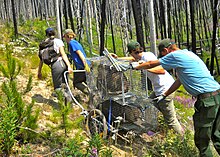Methow River
| Methow River | |
|---|---|
Okanogan County | |
| Cities | Winthrop, Twisp, Pateros |
| Physical characteristics | |
| Source | Cascade Range |
| • location | Methow Pass |
| • coordinates | 48°35′9″N 120°44′44″W / 48.58583°N 120.74556°W[1] |
| • elevation | 5,677 ft (1,730 m)[2] |
| Mouth | Columbia River |
• location | Pateros |
• coordinates | 48°3′2″N 119°53′43″W / 48.05056°N 119.89528°W[1] |
• elevation | 784 ft (239 m)[2] |
| Length | 80 mi (130 km)[3] |
| Basin size | 1,825 sq mi (4,730 km2)[4] |
| Discharge | |
| • location | mouth[5] |
| • average | 1,522 cu ft/s (43.1 m3/s)[5] |
| • minimum | 150 cu ft/s (4.2 m3/s) |
| • maximum | 27,200 cu ft/s (770 m3/s) |
| Basin features | |
| Tributaries | |
| • left | Lost River, Chewuch River |
| • right | Early Winters Creek, Twisp River |
The Methow River (/ˈmɛthaʊ/ MET-how)[6] is a tributary of the Columbia River in northern Washington in the United States. The river's 1,890-square-mile (4,900 km2) watershed drains the eastern North Cascades, with a population of about 5,000 people. The Methow's watershed is characterized by relatively pristine habitats, as much of the river basin is located in national forests and wildernesses. Many tributaries drain the large Pasayten Wilderness. An earlier economy based on agriculture is giving way to one based on recreation and tourism.
History
The river was named after the
Course
The Methow River, along with its tributaries the Twisp River, Cedar Creek, and Early Winters Creek, originates in a cluster of high mountains including
The Pacific Crest Trail follows the uppermost reach of the Methow River, until the river turns east, flowing into the Methow Valley near Mazama. Along the way, it collects the tributary streams of Robinson Creek and Lost River. In the Methow Valley, between Mazama and Winthrop, the Methow River is joined by Early Winters Creek, Cedar Creek, Goat Creek, and Wolf Creek. The Chewuch River joins at Winthrop. One of the Methow's larger tributaries, the Chewuch River, and its many tributaries drain large parts of the Pasayten Wilderness to the north. One of its headwater streams, Cathedral Creek, reaches nearly to British Columbia, Canada.
The Methow Valley continues below Winthrop to Twisp, where the Methow River is joined by another important tributary, the Twisp River. Flowing from the west, the Twisp River drains the mountains south of Washington Pass as well as the eastern slopes of Sawtooth Ridge, a major mountain range with some of Washington state's highest peaks (such as Star Peak and Mt Bigelow).
Downriver from Twisp, the Methow River passes by the communities of Carlton and Methow, receiving several minor tributaries, before joining the Columbia River at Pateros. This part of the Columbia is the impoundment of Wells Dam, a lake known as Lake Pateros.
Ecology and conservation
In Robertson v. Methow Valley Citizens Council (a 1989 Stevens decision) the Rehnquist Court concluded
that
NEPA does not require a fully developed plan detailing what steps will be taken to mitigate adverse environmental impacts and does not require a "worst case analysis." In addition, we hold that the Forest Service has adopted a permissible interpretation of its own regulations.

Since 2007, the Methow Beaver Project has translocated over 240 "problem"
See also
- List of rivers of Washington
- Tributaries of the Columbia River
- Methow, Washington
References
- ^ USGSGNIS.
- ^ a b Google Earth elevation for GNIS coordinates.
- ^ Methow River Archived 2004-12-24 at the Wayback Machine, The Columbia Gazetteer of North America. 2000.
- ^ "Wenatchee Subbasin Plan". Northwest Power and Conservation Council. Retrieved 30 July 2009.
- ^ a b http://pubs.usgs.gov/wdr/2005/wdr-wa-05-1/ Water Resources Data-Washington Water Year 2005
- ^ Webster's Geographical Dictionary.
- ISBN 978-0-8061-3598-4. Retrieved 11 April 2011.
- ISBN 0-295-95158-3.
- JSTOR 20609949.
- ^ Meany, Edmond S. (1920). "Origin of Washington Geographic Names". The Washington Historical Quarterly. XI. Washington University State Historical Society: 204. Retrieved 2009-06-11.
- ^ Ann McCreary (Jan 24, 2016). "Beavers may be part of answer to climate change". Methow Valley News. Retrieved Jan 24, 2016.
- ^ Ben Goldfarb (Nov 9, 2015). "The beaver whisperer". High Country News. Retrieved Jan 24, 2016.
